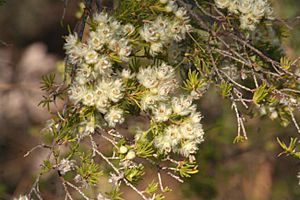Tropical featherflower facts for kids
Quick facts for kids Tropical featherflower |
|
|---|---|
 |
|
| Verticordia verticillata in the Keep River National Park | |
| Scientific classification | |
| Genus: |
Verticordia
|
| Species: |
verticillata
|
The Tropical featherflower, also known as Verticordia verticillata, is a beautiful flowering plant. It belongs to the myrtle family, called Myrtaceae. This plant is special because it is only found in certain parts of northern Northern Territory and Western Australia. This means it is endemic to those areas.
The Tropical featherflower can be a woody shrub or a small tree. It has long, thin leaves that grow in circles, called whorls. In spring, you can see its creamy-white flowers growing in groups.
Contents
What Does the Tropical Featherflower Look Like?
The Tropical featherflower is a shrub or small tree that branches out. It can grow up to 6 m (20 ft) tall and 2 m (7 ft) wide. This plant has a special woody swelling at its base called a lignotuber. This helps it regrow after a fire.
Its leaves are arranged in groups of three or four, like a circle. They are long and thin, shaped like a line. The leaves are about 6–30 mm (0.2–1 in) long and 0.5 mm (0.02 in) wide. They have a pointed tip.
The Flowers of the Tropical Featherflower
The flowers have a light scent. They grow in groups where the leaves meet the stem. Each flower sits on a stalk that is about 8–15 mm (0.3–0.6 in) long. The base of the flower, called the floral cup, is shaped like half a ball. It is smooth and about 1.5–2 mm (0.06–0.08 in) long.
The sepals are creamy-white and spread out. They are about 5–7 mm (0.2–0.3 in) long and have about six hairy parts. The petals are also creamy-white and shaped like an egg. They are about 4–5 mm (0.16–0.20 in) long. The petals are joined together for about 1 mm (0.04 in) of their length. They have uneven, jagged edges.
The style is a part of the flower that is about 9–13 mm (0.4–0.5 in) long. It is straight and has tiny hairs just below its tip. This plant usually flowers from August to October. Sometimes, it can flower at other times if there has been rain.
How to Tell it Apart from Similar Plants
You can tell the Tropical featherflower apart from similar plants like Verticordia cunninghamii and Verticordia decussata. It has leaves that grow in whorls (circles). Also, its style is much longer than these other plants.
Naming the Tropical Featherflower
The scientific name for the Tropical featherflower is Verticordia verticillata. It was first officially described in 1977. A botanist named Norman Byrnes described it. He found a sample of the plant at Eva Valley Station in the Northern Territory. His description was published in a science journal called Austrobaileya.
The second part of its name, verticillata, comes from a Latin word. Verticillus means "a whorl" or "a circle". This name was chosen because of how the leaves grow in circles around the stem.
Where the Tropical Featherflower Grows
The Tropical featherflower is found in many places. It grows across the Kimberley region in Western Australia. It is also found in the northern part of the Northern Territory. This includes some islands off the coast.
You can find this plant growing in sandy soil. Sometimes, the soil might also have loam or gravel. It usually grows in open areas with shrubs and trees.
Protecting the Tropical Featherflower
Good news! The Tropical featherflower is not considered to be in danger. The Western Australian Government's Department of Parks and Wildlife says it is "not threatened". In the Northern Territory, it is classified as "of least concern". This means there are plenty of these plants around.

